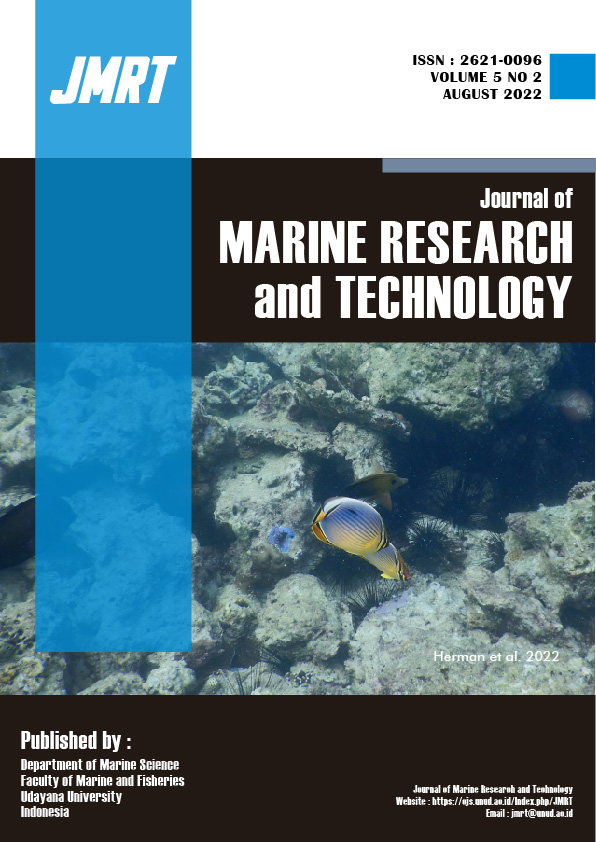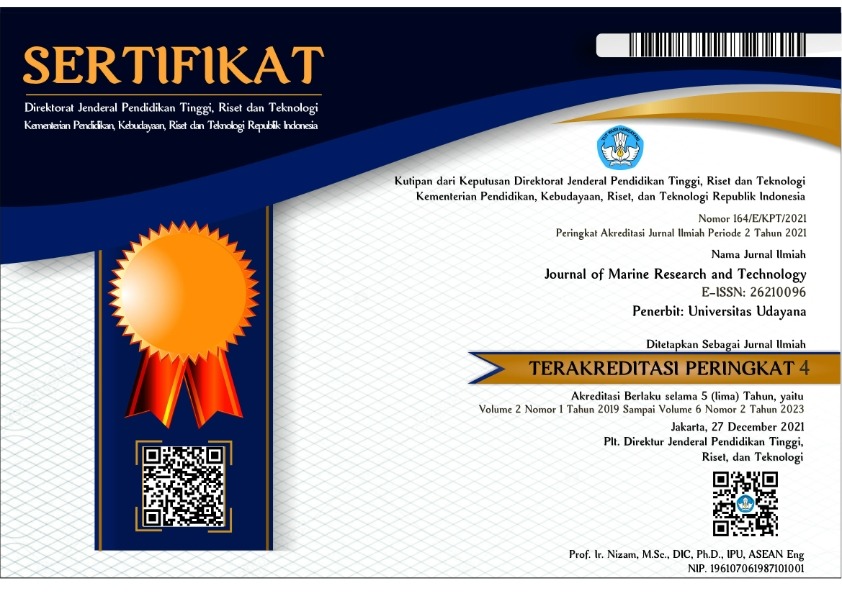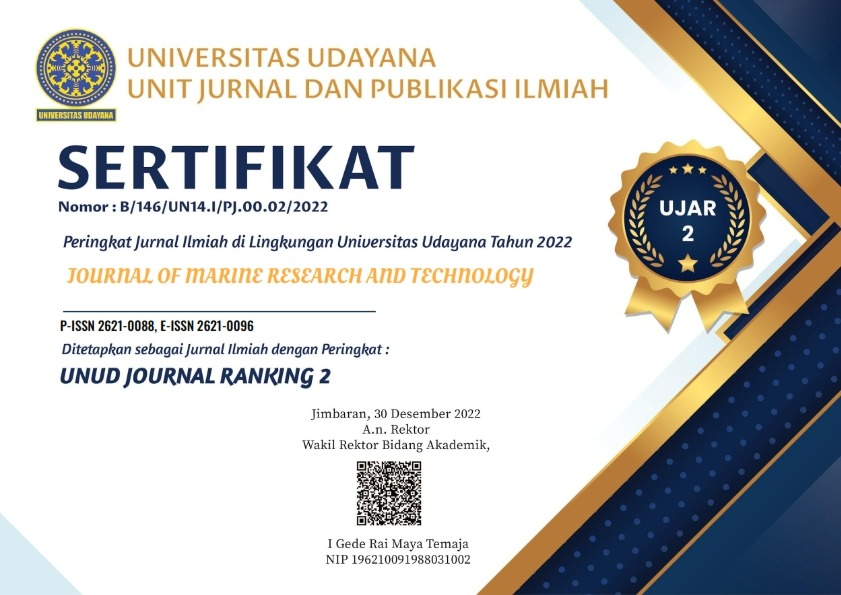Analisis Karbon dalam Sedimen pada Ekosistem Lamun di Teluk Gilimanuk, Bali
Carbon Stock; Gilimanuk Bay; Seagrass; Sediment
Abstract
The increased CO2 emissions in the atmosphere have caused several environmental changes. Therefore, a larger CO2 absorption capacity is required. Seagrass can absorb carbon relatively fast and able to store it. Seagrass beds can trap sediment, so the absorption of organic carbon from the sediment by seagrass can be influenced by the size of the substrate. It has been found that the larger the substrate grain, the lower the ability of plants to absorb the organic matter. This study aimed to determine the seagrass density and cover as well as carbon storage in seagrass bed sediments. The variable measured was Sediment-Organic Carbon Content (S-OCC) and Sediment-Organic Carbon Stock (S-OCS) of seagrass ecosystems in Gilimanuk Bay. Employing purposive sampling, 20 sampling points were selected randomly where seagrass beds were present. The data were obtained using a 1×1m quadrant transect. The carbon content of the sediment was calculated by the Loss of Ignition (LOI) method by removing organic matter at a temperature of 600? in a furnace. This study found four seagrass species: Enhalus acoroides, Cymodocea rotundata, Cymodocea serrulate, and Halophila ovalis. The average density of seagrasses in this habitat ranged from 17 – 179 #/m2, with seagrass cover values ranging from 25 to 100%. The sediment carbon content, measured as carbon stock, on seagrass ecosystems at Gilimanuk Bay was 0.21% - 5.51% for S-OCC and 0.002 – 0.059 g Corg cm-3 for S-OCS. Total S-OCS in Gilimanuk Bay was 11165.84 Mg g Corg.
Downloads
References
Cappenberg, H.A.W., A. Aziz, I. Aswandy. 2006. Komunitas Moluska di Perairan Teluk Gilimanuk, Bali Barat. Oseanologi dan Limnologi No. 40: 53-64. ISSN 0125-9830.
Cyle, K. T., N. Hill, K. Young, T. Jenkins, D. Hancock, P. A. Schroeder, A. Thompson. 2016. Substrate Quality Influences Organic Matter Accumulation in The Soil Silt and Clay Fraction. Soil Biology and Biochemistry, 103: 138-148.
Duarte, C.M., dan J. Cebrian. 1996. The Fate of Marine Autotrophic Production. Limnology and Oceanograph 18 (4):1758-1766.
Ferawati, R., J. Nugroho, Y. Rahakratat. 2008. Biomassa dan Penyerapan Karbon oleh Lamun Enhalus acoroides di Pesisir Teluk Gunung Botak Papua Barat. Jurnal Sumberdaya Akuatik Indopasifik. Vol 2. No 2.
Fourqurean, J. W., G. A. Kendrick, L. S. Collins, R., M. Chambers dan M. A. Vanderklift. 2012. Carbon, Nitrogen and Phosphorus Storage in Subtropical Seagrass Meadows: Examples from Florida Bay and Shark Bay. Marine and Freshwater Research. Csiro Publishing.
Fourqurean, J. W., B. Johnson, J. B. Kauffman, H. Kennedy, I. Emmer, J. Howard, E. Pidgeon, O. Serrano. 2014. Conceptualizing the project and Developing a Field Measurement Plan. Coastal Blue Carbon: Methods for Assessing Carbon Stock and Emissions factor in Mangrove, Tidal Salt Marsh and Seagrass Meadow. The Blue Carbon Initiative. 39 - 107 hal.
Gacia, E., T. C. Granata and C. Duarte. 1999. An approach to measurement of particle flux and sediment retention within seagrass (Posidonia oceanica) meadows. Aquat. Bot. 65: 255–268.
Gosari B. A. J., Haris A. 2012. Studi Kerapatan dan Penutupan Spesies lamun di Kepulauan Spermonde. Jurnal Ilmu Kelautan dan Perikanan. 22 (03): 156-162.
Graha Y. I., I. W. Arthana, I. W. G. A. Karang. 2016. Simpanan Karbon Padang Lamun di Kawasan Pantai Sanur, Kota Denpasar. Jurnal Ilmu Lingkungan. 10 (1): 46-53.
Handayani, D.R., Armid., Emiyarti., 2016. Hubungan kandungan nutrien dalam substrat terhadap kepadatan lamun di Perairan Desa Lalowaru Kecamatan Moramo Utara. 1(2): 2503-0396.
Hemminga, M.A., dan C.M. Duarte. 2000. Seagrass Ecology. United Kingdom: Cambridge University Press.
IPCC. 2017. Climate Change 2007: The Physical Science Basis. Contribution of Working Group l to the Fourth Assessment Report of the IPCC. Solomon, S., D. Qin, M. Manning, Z. Chen, M. Marquis, K.B. Averyt, M. Tignor dan H.L. Miller (eds.) ed. Cambridge, United Kingdom, dan New York: Cambridge University Press.
Ira, Oetama D, Juliati. 2013. Kerapatan dan Penutupan Lamun pada Daerah Tanggul Pemecah Ombak di Perairan Desa Terebino Propinsi Sulawesi Tengah. Aquasains: Jurnal Ilmu Perikanan dan Sumberdaya Perairan. Volume 2, No. 1:89-96.
Kauffman, J.B. dan Daniel C. Donato. 2012. Protocols for The Measurement, Monitoring and Reporting of Structure, Biomass and Carbon Stocks in Mangrove Forest. CIFOR.
Laffoley, D. dan G. Grimsditch. 2009. The Management of Natural Coastal Carbon Sinks. Gland, Switzerland: IUCN.
Lestari, K.I.V., I.G. Hendrawan, E. Faiqoh. 2020. Estimasi Simpanan Karbon pada Padang Lamun di Kawasan Pantai Karang Sewu, Gilimanuk, Bali. Journal of Marine Research and Technology. ISSN: 2621-0096.
Mateo, M.A., J. Romero, dan M. Perez. 1997. Dynamics of Millenary Organic Deposits Resulting from the Growth of the Mediterranean Seagrass Posidonia oceanica. Estuarine, Coastal and Shelf Science 44:103-110.
NOAA. 2018. Recent Global CO2. Diakses September 2020. https://gml.noaa.gov/ccgg/trends/.
Nontji, A. 2002. Laut Nusantara. Cetakan ketiga. Penerbit Djambatan, Jakarta: 367 hal.
Nurzahraeni. 2014. Keragaman Jenis dan Kondisi Padang Lamun di Perairan Pulau Panjang Kepulauan Derawan Kalimantan Timur. [Skripsi]. Jurusan Ilmu Kelautan. Fakultas Ilmu Kelautan Dan Perikanan. Universitas Hasanuddin. Makassar.
Odum, E. P. 1971. Dasar-Dasar Ekologi. Edisi Ketiga Gadjah Mada University Press. Yogyakarta.
Rahmawati, S., Irwan A., Supriyadi I.H., dan Azkab, M.H. 2014. Panduan Monitoring Padang Lamun. COREMAP – CTI. Lembaga Ilmu Pengetahuan Indonesia (LIPI).
Rahmawati, S., Udhi E., Hernawan, K. McMahon, B. Prayudha, H.B. Prayitno, A.J. Wahyudi, M. Vanderklift. 2019. Blue Carbon in Seagrass Ecosystem; Guideline for the Assessment of Carbon Stock and Sequestration in Southeast Asia. Gadjah Mada University Press. Yogyakarta.
Rosalinda, R. 2006. Konektivitas Ikan Pada Ekosistem Padang Lamun dan Terumbu Karang di Teluk Gilimanuk, Taman Nasional Bali Barat, Provinsi Bali. [Skripsi]. Institut Pertanian Bogor.
Sakaruddin, M. I. 2011. Komposisi Jenis, Kerapatan, Persen Penutupan dan Luas Tutupan lamun di Perairan Pulau Panjang Tahun 1990 – 2010. [Skripsi]. Departemen Ilmu dan Teknologi Kelautan. Fakultas Perikanan dan Ilmu Kelautan. Institut Pertanian Bogor. Bogor.
Santisteban, J. I., M. J. Gil-Garcia, C. J. Dabrio, S. C. Castano. 2004. Loss on Ignition: a Qualitative or Quantitative method for Organic Matter and Carbonate Mineral Content in Sediments?. Journal of Paleolimnology. 32(3), pp. 287-299. Doi: 10.1023/B: JOPL.0000042999.30131.5b.
Santoso B, I. G. B. S. Dharma, E. Faiqoh. 2018. Pertumbuhan dan Produktivitas Daun Lamun Thalassia hemprichii (Ehrenb) Ascherson di Perairan Tanjung Benoa, Bali. Journal of Marine and Aquatic Sciences. Volume 4, No. 2: 278-286.
Sary. 2006. Bahan Kuliah Manajemen Kualitas Air. Politehnik Vedca. Cianjur.
Supriadi, M., R. F. Kaswadji, D. G. Bengen dan M. Hustomo. 2014. Carbon Stock of Seagrass Community in Barranglompo Island, Makassar. Ilmu Kelautan. 19 (1). Hal 1-10.
Tenribali. 2015. Sebaran dan Keragaman Makrozoobentos serta Keterkaitannya dengan Komunitas Lamun di Calon Kawasan Konservasi Perairan Daerah (KKPD) di Perairan Kabupaten Luwu Utara. Skripsi. Program Studi Ilmu Kelautan. Departemen Ilmu Kelautan. Fakutas Ilmu Kelautan dan Perikanan. Universitas Hasanuddin. Makassar.
Walker, B., dan W. Steffen. 1997. An Overview of The Implication of Global Change for Natural and Managed Terrestrial Ecosystems. Conservation Ecology 1 (2).
Wardoyo, S.T.H. 1978. Kriteria Kualitas Air Untuk Keperluan Pertanian dan Perikanan. Prosiding Seminar Pengendalian Pencemaran Air. (eds Dirjen Pengairan Dep. PU.), hal 293-300.
Yunitha, A. 2015. Kandungan C-Organik pada Lamun Berdasarkan Habitat dan Jenis Lamun di Pesisir Desa Bahoi Kabupaten Minahasa Utara, Sulawesi Utara. [Thesis]. Sekolah Pascasarjana, Institut Pertanian Bogor, Bogor
Zhou, Tao, P. Shi, G. Jia, Y. Dai, X. Zhao, W. Shangguan, L. Du, H. Wu dan Y. Luo. 2015. Age-dependent Forest Carbon Sink: Estimation via Inverse Modeling. Journal of Geophysical Research: Biogeosciences 120 (12): 2473-2492. Doi: 10.1002/2015jg002943.
Zurba, N. 2018. Pengenalan Padang Lamun, Suatu Ekosistem yang Terlupakan. Unimal Press. Sulawesi.
Copyright Notice
The copyright to this article is transferred to Journal of Marine Research and Technology (JMRT). The copyright transfer covers the exclusive right and license to reproduce, publish, distribute and archive the article in all forms and media of expression now known or developed in the future, including reprints, translations, photographic reproductions, microform, electronic form (offline, online) or any other reproductions of similar nature.






